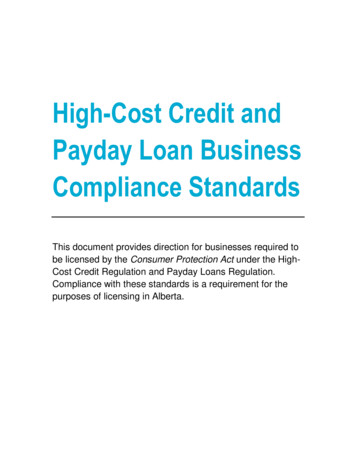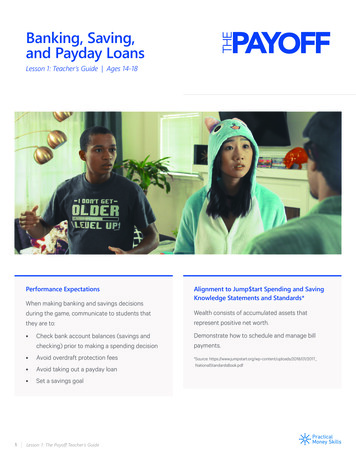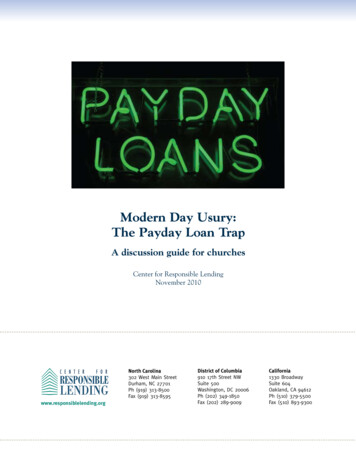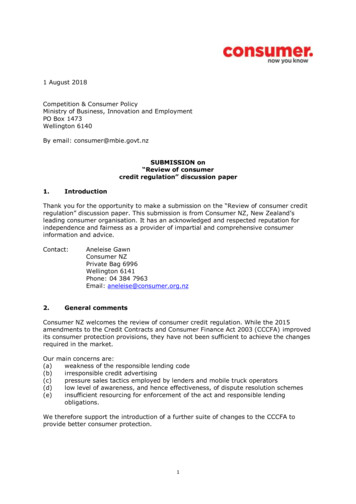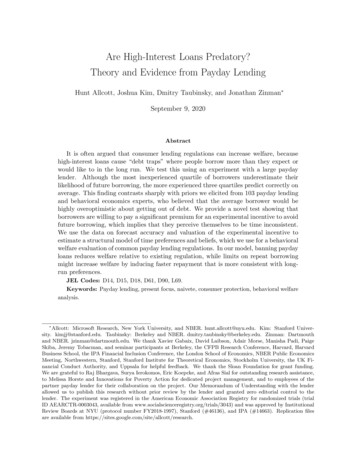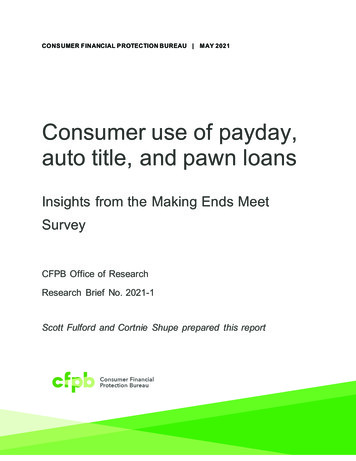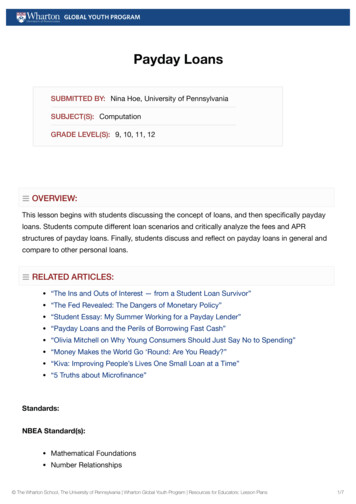
Transcription
Payday LoansSUBMITTED BY: Nina Hoe, University of PennsylvaniaSUBJECT(S): ComputationGRADE LEVEL(S): 9, 10, 11, 12 OVERVIEW:This lesson begins with students discussing the concept of loans, and then specifically paydayloans. Students compute different loan scenarios and critically analyze the fees and APRstructures of payday loans. Finally, students discuss and reflect on payday loans in general andcompare to other personal loans. RELATED ARTICLES:“The Ins and Outs of Interest — from a Student Loan Survivor”“The Fed Revealed: The Dangers of Monetary Policy”“Student Essay: My Summer Working for a Payday Lender”“Payday Loans and the Perils of Borrowing Fast Cash”“Olivia Mitchell on Why Young Consumers Should Just Say No to Spending”“Money Makes the World Go ‘Round: Are You Ready?”“Kiva: Improving People’s Lives One Small Loan at a Time”“5 Truths about Microfinance”Standards:NBEA Standard(s):Mathematical FoundationsNumber Relationships The Wharton School, The University of Pennsylvania Wharton Global Youth Program Resources for Educators: Lesson Plans1/7
Patterns, Functions, and AlgebraProblem SolvingCommon Core Standard(s):A-SSE.1. Interpret expressions that represent a quantity in terms of its contextA-CED.1. Create equations and inequalities in one variable and use them to solveproblems. Include equations arising from linear and quadratic functions, and simplerational and exponential functions.Objectives/Purposes: Students will understand the payday loans as a social practice andcompute the true APRs associated with fee based loans.Knowledge@Wharton Articles:“More Savings, Less Plastic: Consumer Credit after the Crisis”Other Resources/Materials:CalculatorsWhole Class Discussion:Student WorksheetLoans (10 mins)Orient students to the idea of borrowing money, loans, and why people do these things.1. Do you always have enough money to buy what you want to buy?2. What do you do if want to make a purchase for something you do not have enoughmoney for?3. What are some examples of things that you, or any consumer, might want to buy andmight not have enough money to buy outright?4. How do people get access to money?5. What is a loan?6. What does it mean to loan someone money or to be a lender?7. What does it mean to receive money from a lender or to be a borrower? The Wharton School, The University of Pennsylvania Wharton Global Youth Program Resources for Educators: Lesson Plans2/7
8. What are the incentives for banks or other entities to lend money to borrowers? (i.e. isthis ever done for free?)Use student definitions of a loan to articulate a succinct definition from which students can work.Example: A loan is a type of debt, typically a sum of money that is borrowed and is expected tobe paid back (in most cases) with interest. A loan involves a lender, who provides the money,and the borrower, who uses the money and then pays it back to the lender over a specified termor period of time. The initial amount of loaned from the lender to the borrower is the principal.Banks or other entities DO NOT usually lend money for free. They charge interest on loans,which is how they generate revenue, or income. However, different types of loans are structuredin different ways with different interest rates and payment plans. Generally, there are two types ofloans – secured and unsecured. Secured loans mean that there is some sort of security for thelender, or collateral, in case the borrower does not pay the loan back. Examples of this are homeloans or car loans, whereby if the borrower defaults, or fails to make appropriate payments, thelender could take the home or car and resell it to recover the money lent. There are alsounsecured loans, where there is no collateral for the lender, so if the borrower fails to pay theloan or declares bankruptcy, then the lender may loose the money all together. Examples of thisare credit card loans or personal loans. Generally, interest rates are higher for unsecured loansand lower for secured loans. Additionally, the term, or amount of time, the borrower will take topay back the loan has an effect on the interest rate. Generally, shorter term loans will have lowerinterest rates than loans with longer terms. Also, a persons credit rating, may determine theinterest rate s/he gets. A credit rating is an estimate of the ability of a person or organization tofulfill their financial commitments, based on previous dealings (i.e. do you have a history of notpaying back loans?).Payday Loans (15 mins)1. What is a payday loan? (Has anyone ever heard of this?)2. Where are these administered? (Check cashing places, not banks)Break students into groups to read the following description and answer questions.Payday loans, also known as paycheck advances or cash advances, are small, short-terms loansextended to borrowers in advance of their next paycheck. Laws regarding payday loans and theirinterest rates and fees range from country to country and state to state in the US. In some states The Wharton School, The University of Pennsylvania Wharton Global Youth Program Resources for Educators: Lesson Plans3/7
the APR and fees are regulated, in others it’s not, and in some states payday loans are illegalaltogether. While borrowers typically need to provide some sort of proof of employment such as apay stub or bank statement, this is an unsecured loan. Thus, interest rates and fees are higher.Typically, a borrower writes a backdated check to the lender for the amount borrowed plus thefee. The lender then attempts to cash the check once the borrower has received his paycheck.However, payday loans have a high default rate – 10 – 20% – so the fees that are associated withthese loans often translate to APRs of over 300%. For example, fees for loans of less than twoweeks can be 110 for a 500 loan or 15 for a 500 loan. The term for these loans is typically 14days (or 2 weeks) To calculate the APRs from these fees, multiply the term interest rate (15/100 15%) by the number of terms in a year. For example, for a 14-day/2-week loan, an interest rateof 15% is not descriptive of an APR. Instead, 15% must be multiplied by 365/14 to represent thenumber of 14-day periods in a year. This then corresponds to an APR of 391%. Sometimes, if aborrower cannot pay back the payday loan in the given amount of time, he/she can pay the feefor that period, and carry the balance over, along with another fee, for an additional two weeks.Payday loans are particularly prevalent in low-income communities that have received harshcriticism for their treatment of low-income borrowers. These loans are sometimes called“predatory” loans, as they quickly drain money from low-income families, exploitfinancial hardship for profit, and have often been associated with aggressive, and illegal,collection processes. However, proponents of these loans believe that they provide an importantservice that otherwise would not be available to people in need to short-term loans.1. Are payday loans a good or a bad thing?2. What are some of benefits/positives of this service?3. What are some of the negatives?4. What are reasons that someone might need a payday loan? (Medical emergency,unexpected home or car repair needed, etc.)5. Do you know anyone who has ever taken out a payday loan?6. If so, what did they have to say about the process?7. If you were a lender (a person with money to lend), what would be reasons to offerpayday loans?8. What would be reasons not to offer payday loans?Reconvene as a class and ask groups to report their answers.Small Group/Pair Activity: (15 mins)Recall the formula for simple interest The Wharton School, The University of Pennsylvania Wharton Global Youth Program Resources for Educators: Lesson Plans4/7
where,I is the interest owedP is the principal amount outstandingr is the interest ratet is the time in years.Note: to express 1 month in terms of years, divide by 12, so that to calculate the interest over aperiod of 1 month, t 1/12Recall the general form for compound interest (an exponential growth model) is the equation:where, P is the principal amount, or the original amount of money before any growthoccursr is the annual nominal interest rate or the growth rate in decimal formn is the number of times the interest is compounded per yeart is the number of years, and A is the new amount.Formula for Interest Compounded Daily:1. What is the APR on a 2-week loan of 300 with a 50 fee? (433%)2. Lenders receive a lot of criticism for having such high APRs. However, what do lowAPRs look like for lenders? Calculate the profit for a lender (or the interest charged) on a2-week loan with an APR of 5%. Let the interest compound daily during that period oftime. (Use the compound interest formula. Let t 14/365). (A 300.58 – the lenderwould only make 0.58 for loaning 300 to someone for 2 weeks.)3. Which seems fair? What is sustainable?4. Because of the high default rate, what do you think sounds like a fair profit for lenders?5. At what fee price do you think borrowers would say NO? The Wharton School, The University of Pennsylvania Wharton Global Youth Program Resources for Educators: Lesson Plans5/7
(Tell students they can “divide and conquer” for this section.)1. The “Check n’ Go” websiteshows the allowed borrowing amount and computespayments for borrowers online. Some states do not prohibit this service altogether.Compute the APR rates for the following loans advertised on this website. All loans arebased on a 14-day loan term.1. Borrow 30 in California – Finance Charge 5.292. Borrow 30 in Texas – Finance Charge 7.613. Borrow 100 in Illinois – Finance Charge 15.504. Borrow 100 in Alabama – Finance Charge 17.505. Borrow 500 in Missouri – Finance Charge 1256. Borrow 500 in Kansas – Finance Charge 757. Borrow 1,000 in Idaho – Finance Charge 2508. In Delaware, the finance charge is always 25% of the amount borrowed. Whatis the corresponding the APR?9. Which states appear to have the highest APRs? Give the percentage.10. Which states appear to have the lowest APRs? Give the percentage.11. An individual borrowed 500 as a Payday Loan and the Finance Charge was 110. For the following two weeks he was unable to make the payment, andwas thus charged another 110 for those weeks. Finally, after the third week,he had money to pay back the loan.1. How much did he owe total?2. At what APR did he end up borrowing?12. If you borrowed 1,000 in a personal loan from your bank for a 1-year term atan APR of 13% compounded daily, how much would you pay back in the end?What is the total amount of interest?13. Comparing the cost of taking a 1,000 payday loan in Idaho (see 6g), how dothe payday loan finance charge and the bank loan interest compare to oneanother?14. Why do you think some people chose a payday loan, with a higher APR andhigher fees altogether, and a shorter term, instead of a personal bank loan?Tying It All Together:Whole Class Discussion (10 mins)1. Why do people borrow from check cashing places and take out payday loans if theinterest rates are so high and terms are so short? Have students share their ideas from The Wharton School, The University of Pennsylvania Wharton Global Youth Program Resources for Educators: Lesson Plans6/7
#13.2. What services do these loans provide?3. What are the dangers?4. Who do you think ultimately benefits from this system?5. What are other alternatives?Extending the ActivityRead the Wharton Global Youth Program article: “Kiva: Improving People’s Lives One Small Loanat a Time”1. How does this model relate to the Kiva model?2. What are the differences?3. What are the similarities?4. What is the default rate on Kiva loans?1. How/why do you think this so different from payday loans?Practice Outside of the Classroom:Look around to see “Check Cashing” and “Payday Loan” services. Observe their advertisedrates/fees.Sources/Resources:What Worked and What I Would Do Differently Next Time: The Wharton School, The University of Pennsylvania Wharton Global Youth Program Resources for Educators: Lesson Plans7/7
However, payday loans have a high default rate - 10 - 20% - so the fees that are associated with these loans often translate to APRs of over 300%. For example, fees for loans of less than two weeks can be 110 for a 500 loan or 15 for a 500 loan. The term for these loans is typically 14

